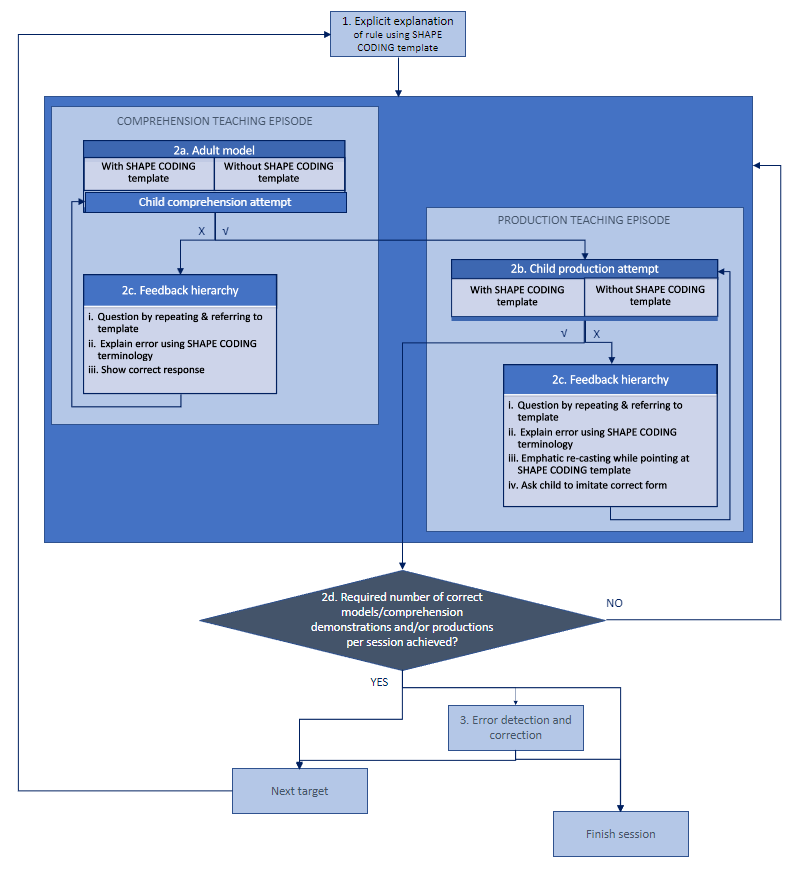General techniques when using the SHAPE CODING™ system
Intervention with the SHAPE CODINGTM system uses a variety of techniques in a series of steps which are summarised in the Figure and detailed below. These steps can be used for all targets (although the comprehension steps may be less relevant to some targets). For specific details of the rules and their explanations, please see the intervention steps for each individual target.

- Intervention step 1: adult gives an explicit explanation of the target rule using the relevant SHAPE CODINGTM template, either using physical or drawn shapes, or on the app. If possible and appropriate, the adult puts small figures or objects on the ovals and rectangles and then uses them to act out the meaning of the sentence
- Intervention step 2 (This is the main body of all sessions and may well be repeated – we have found 20 repetitions is feasible in 15 minutes)
-
- Intervention step 2a: adult models the structure while pointing at the corresponding SHAPE CODINGTMtemplate. Child acts out or points to picture if appropriate to show comprehension (adult provides feedback for any comprehension errors)
- Intervention step 2b: adult elicits oral and or written production of the target structure by the child in response to pictures and / or videos and / or acted out scenarios using toy animals. The adult and/or child points to the relevant parts of SHAPE CODINGTM template during production. If the child is able to produce the structure accurately with SHAPE CODINGTM template on several consecutive occasions (we aim for 5), the adult then removes the template so that the child (and adult) produce the structure without this visual support. This is likely to occur earlier in later sessions on a particular target, as the required level of support reduces. However, if the child then makes two errors without the visual support, the adult reintroduces the SHAPE CODINGTM template. Adult acts out child’s sentence if appropriate to demonstrate the meaning of the child’s sentence.
- Intervention step 2c: If the child makes an error at any point during the protocol, a feedback hierarchy is followed, whereby continued errors lead to the next step of the hierarchy being used.
-
-
- Feedback hierarchy step i: For production errors: question the child by repeating the child’s error with a questioning intonation and if SHAPE CODINGTM template is still visible, refer the child to this. For comprehension errors, ask the child if they are sure about their response.
- Feedback hierarchy step ii: explicitly explain the error using SHAPE CODINGTM terminology and ask the child to try again.
- Feedback hierarchy step iii (for production errors only): use emphatic recasting, while pointing to the SHAPE CODINGTM template at the place in which the error occurs.
- Feedback hierarchy step iv: For production errors: ask the child to imitate the correct structure. For comprehension errors: show the child the correct response while saying the sentence.
-
-
- Intervention step 2d: adult and child then take turns producing sentences containing the target structure, until the desired number of correct productions (by both adult and child) is reached. This may be done as an isolated activity, for example giving instructions to act out, or the adult may set up situations where the targeted structures are likely to be used or where instructions including the target need to be followed (e.g., describing pictures or a video, in play or in conversation). The feedback hierarchy is again used for any errors.
- Intervention step 3: Once the child is able to produce/comprehend the target structure reliably without reference to the SHAPE CODINGTM template, focus on error detection and correction. Here the aim is to develop the student’s self-monitoring skills by the adult reversing roles with the child, producing some deliberate errors and encouraging the child to identify and correct them.
Feedback hierarchy examples for oral errors
| Step in feedback hierarchy for oral errors | Example production errors and feedback | |||
|---|---|---|---|---|
| “the man put in the bowl the apple” | “the man running” | “yesterday, the boy walk” | “the boy and the girl is running” | |
| 1. For production errors: question the child by repeating the child’s error with a questioning intonation and if SHAPE CODINGTM template is still visible, refer the child to this. For comprehension errors, ask the child if they are sure about their answer. |
 “the man put in the bowl the apple?” (point at the template as you speak, pointing at the semi-circle before the rectangle)
“the man put in the bowl the apple?” (point at the template as you speak, pointing at the semi-circle before the rectangle) |
 “the man running?” (point at template as you speak, say nothing when pointing at the diamond)
“the man running?” (point at template as you speak, say nothing when pointing at the diamond) |
 “yesterday, the boy walk?” (point at the template as you speak, particularly highlighting the “-ed”)
“yesterday, the boy walk?” (point at the template as you speak, particularly highlighting the “-ed”) |
 “the boy and the girl is running?” (point at the template as you speak, particularly highlighting the double line on the diamond)
“the boy and the girl is running?” (point at the template as you speak, particularly highlighting the double line on the diamond) |
| 2. explicitly explain the error using SHAPE CODINGTM terminology, for example and ask the child to try again. | “you said the semi-circle and the rectangle in the wrong order!” | “you missed out the diamond. This means you missed out the down arrow. You need one down arrow in every sentence/clause” | “you missed out the back arrow on the blue word. It needs to match the back arrow on the WHEN triangle” | “you have two red lines in the big oval, so you need two blue lines on the diamond” |
| 3. (for production errors only): use emphatic recasting, while pointing to the SHAPE CODINGTM template at the place in which the error occurs | “the man put the apple in the bowl” (point at rectangle when you say “the apple” and at the semi-circle when you say “in the bowl”) | “the man is/was running” (point at the diamond when you say “is/was”) | “yesterday, the boy walked” (point at the “ed” and the back arrow as you say “walked”) | “the boy and the girl are running” (point at the diamond double lines as you say “are”) |
| 4. for production errors: ask the child to imitate the correct structure. For comprehension errors: show the child the correct response while saying the sentence. | “Now you say it: the man put the apple in the bowl” | “Now you say it: the man is running” | “Now you say it: yesterday, the boy walked” | “Now you say it: the boy and the girl are running” |

